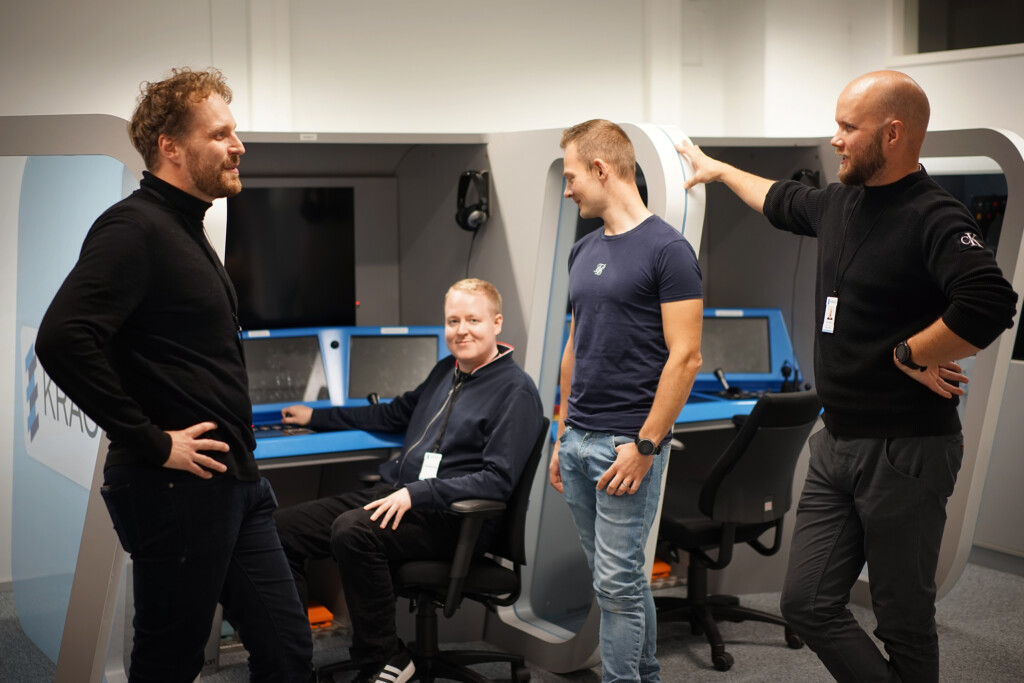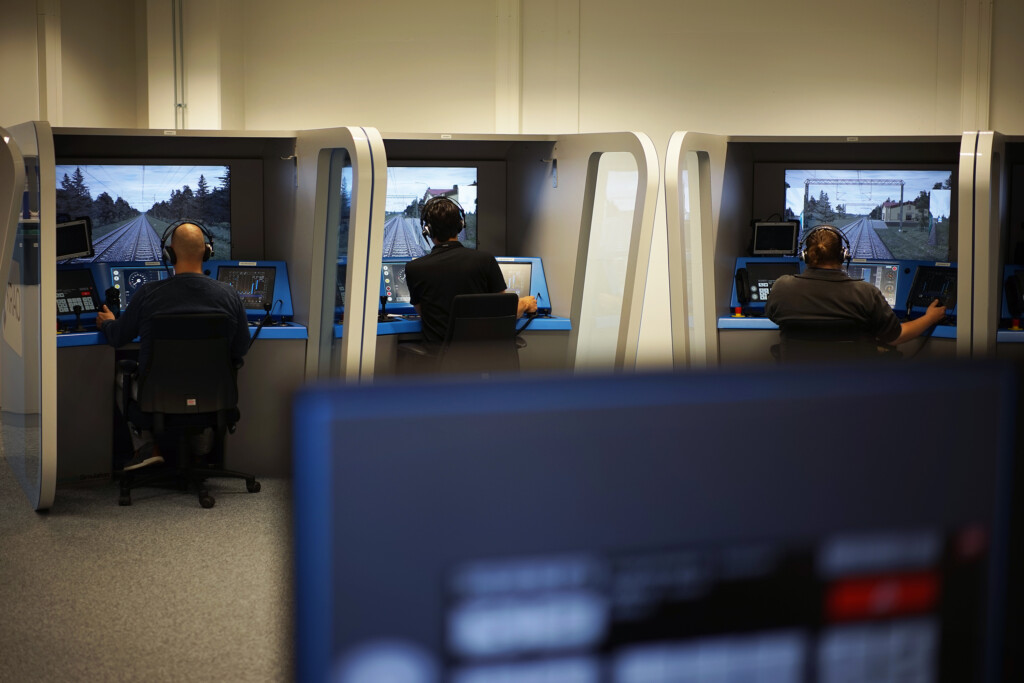In September, the drivers selected for the test driving of the Digirail project were familiarising themselves with the secrets of the new train control system in Kouvola. Traffic on the Kouvola–Kotka–Hamina test section will start towards the end of the year. At the same time, driving in the virtual world will switch to operation in a real railway environment.
In a dimly lit room, there is a long row of computers, with men sitting at them in deep concentration wearing headphones. On the screens in front of them, train tracks are bustling with traffic, and every now and then a series of beeping indicator sounds can be heard. From time to time, one of them picks up the phone which is ringing with a demanding tone. The sight is reminiscent of a retro-inspired arcade with game machines. However, these are simulators that train drivers use to practice driving in a virtual environment.
They have completed a week of contact teaching in the new premises of Kouvola Railway and Adult Education Company KRAO in the centre of Kouvola. The Digirail test drivers are familiar with the secrets of the future ETCS train control system. Today’s lessons have included revising what has been learned before, and participating in exams.
In the room, the situation is being monitored by KRAO’s trainer and expert Jussi Mäkynen, who also has a background as a driver. He explains that the simulator is displaying a view of the Sr3 engine’s, i.e. Vectron’s, driving table and Driver Machine Interface.
Jussi has conducted ETCS test driver training commissioned by the Finnish Transport Infrastructure Agency for a group of students, and half of the drivers are taking the simulator exam. Competence has also been verified by a written test in the same afternoon.
Being part of a pioneering group
In the spring application process, 10 VR test drivers were selected for the student group and the test track traffic. In addition, two VR operation service experts have participated in the training, and for part of the time, there have also been some test track commissioning engineers from different organisations. In this way, the different stakeholders participating in the test drives have had a chance to get to know each other in advance. The test track of the Digirail project shall be located on the Kouvola–Kotka–Hamina track section (KoKoHa).
Ilmala’s operation service specialist and qualified driver Riku Immonen and train driver Toni Lonka from Kouvola walk from the classroom to the lobby after having completed the written theory test swiftly. What have they thought about their participation in the training?
“I applied to become a test driver because I wanted to develop my skills and be involved in a new project that affects so many people. Safety is an important factor in my work and that of everyone else as well. The topic as a whole is interesting because it regards our future, and ETCS shall be used to replace JKV,” Lonka says.
Finland’s current train control system (JKV) is approaching the end of its lifecycle. In the Digirail project, the train control system will be renewed and a modern radio network-based ETCS (European Train Control System) system will be introduced. EU regulation also requires the systems to be harmonised.
“It’s great to be part of a pioneering group in terms of driver operations. This doesn’t happen many times during a person’s career. In the future, ETCS will affect everything we do,” says Immonen, who is also training to become a test drive manager taking care of the safety of test drives.
Training that is first of its kind
Jussi Mäkynen says that the training programme has been constructed together with the Digirail project staff in a driver-centred manner.
This is the first training on the subject for drivers in Finland. This will serve as a benchmark for how it shall be organised in the future, Mäkynen says. There has been some technical aspects involved to provide reasons for why something is happening in the system. In addition, the training has been accompanied by simulator exercises that show in practice what the operation will look like in real life.
Formulating the content of the training programme has also posed a challenge for the trainer, who has sought information on the subject all the way from Brussels.
“There is a huge amount of ETCS background material, and I have been able to independently research and familiarise myself with what would be relevant for the driver,” Mäkynen says. The training has gone well and as expected, and also the feedback has been mainly positive. There is a lot to learn, but on the other hand, there has also been time to digest all the material. We have been able to move forward through discussions, he describes. Everyone passed the final exam commendably, Mäkynen mentions just before the debriefing of the training week is about to begin in the classroom.
Getting to know the background of the test track
The test drivers’ introduction to the new ETCS system entity began with a self-study part, followed by contact teaching and simulator driving at KRAO.
“The training brings all the previously studied material to reality,” Riku Immonen sums up.
What Toni Lonka remembers about the training, for example, is when representatives of the Digirail project arrived for a visit during the first days.
“They explained to us about the background and what has been done so far. It makes it more concrete to know what we are talking about, what we are aiming for and what our time window is,” Lonka says. We have learned so many new things regarding the new system. In the simulator, I have had the opportunity to test how everything interacts. We are eagerly waiting to see if everything will work the same way when we start putting things into practice with a real locomotive, he ponders.
From the drawing board to implementation
The extensive Digirail project is renewing the entire infrastructure of the railway control and signalling system: automatic train control, interlockings, control devices and the radio network. Among other things, the Digirail will enable an increase in rail capacity and, thus, an increase in the number of trains and passengers on the current rail network.
“I am pleased that we have been able to implement a comprehensive and high-quality training programme for test drivers in the use of the radio-based ETCS system. This programme has been commissioned by the Finnish Transport Infrastructure Agency in close cooperation with us. It is the first of its kind in Finland,” says Jonas Eriksson, Vice President for the ERTMS programme at VR.
For the testing, the test track will be equipped with a new ETCS train control system, as well as new traffic control systems and a radio network. ETCS test traffic examines the functionality and compatibility of new systems.
“Test drivers have been given a great opportunity to impact the practical implementation of the Finnish ETCS solution. They are at the forefront of bringing a new train control solution to the entire Finnish railway network. There are first-class, open-minded drivers participating in the project. We are now in an inspiring phase, as we can move towards more concrete matters with driver training and the Sr1 test engine; from the drawing board to implementation,” Jonas Eriksson mentions.
A lot of new information for drivers to learn
Test drives are scheduled to begin this autumn on the KoKoHa track. They will also be implemented over the course of next year. An Sr1 test engine will be used for the test runs, which shall be equipped with an ETCS train control system.
“There are two types of system testing. In the so-called shadow mode or shadow test, the ETCS provides information and communicates with trackside equipment, but does not interfere with the movement of the train. In shadow tests, JKV ensures the safe movement of the train. In addition, there are ETCS system tests, in which case the JKV is not in use. This means that the track will then be closed to other traffic, Riku Immonen explains.
Immonen, Lonka and Eriksson explain how there will be significant changes in the work of drivers when the ETCS is finally introduced. Information is provided to the driver from a different location than before, and the role of information technology is further emphasised.
“Trains can be operated without signals visible in the terrain. Almost all the information comes through the ETCS on-board unit, which is the most concrete change, Immonen says.
In addition to the removal of light signals used for traffic control, the previously point-based access control will now be changed to continuous.
“In the future, traffic information will keep being updated in real time as the train moves,” Lonka says.
According to Jonas Eriksson, the basic principle of traffic will change completely.
“From the driver’s point of view, it is not so difficult to learn to use the new system as it is to forget the conformities associated with the previous system, although the transition period will of course be long. You need to know what rules to follow at any given time, Eriksson points out.
“I could even go to the test track right away, full of certain childlike enthusiasm. It’s nice to actually be able to start performing the first tests in late autumn, he says.


